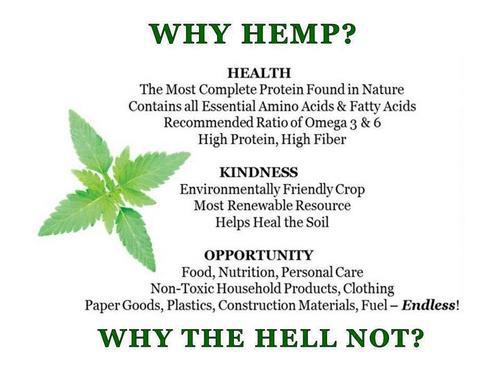Food
Hemp seeds can be eaten raw,
ground into a meal, sprouted, made into hemp milk (akin to soy milk), prepared as tea, and
used in baking. The fresh leaves can also be consumed in salads. Products
include cereals, frozen waffles, hemp milk ice cream, hemp tofu, and nut butters. A few
companies produce value
added hemp seed items that include the seed oils, whole hemp
grain (which is sterilized by law in the United States, where they import it
from China and Canada), dehulled hemp seed (the whole seed without the mineral
rich outer shell), hemp flour, hemp cake (a by-product of pressing the seed for
oil) and hemp protein powder. Hemp is also used in some organic cereals, for
non-dairy milk somewhat
similar to soy and nut milks, and for non-dairy hemp "ice cream."
Nutrition
Approximately 44% of the weight
of hempseed is edible oils, containing about 80% essential fatty acids (EFAs); e.g., linoleic acid, omega-6 (LA, 55%), alpha-linolenic acid, omega-3 (ALA, 22%), in addition to gamma-linolenic acid, omega-6 (GLA, 1–4%) and stearidonic acid, omega-3 (SDA, 0–2%). Proteins (including edestin) are the other major component
(33%), second only to soy (35%).
Hempseed's amino acid profile is close to
"complete" when compared to more common sources of proteins such as
meat, milk, eggs and soy. Hemp protein contains all 21 known
amino acids, including the 9 essential ones adult bodies cannot produce.
Proteins are considered complete when they contain all the essential amino
acids in sufficient quantities and ratios to meet the body's needs. The
proportions of linoleic acid and alpha-linolenic acid in one tablespoon (15 ml)
per day of hemp oil easily provides human daily
requirements for EFAs.
Typical nutritional analysis of hulled hemp
seeds
|
|
Calories/100 g
|
567 kcal
|
Protein
|
30.6
|
Carbohydrate
|
10.9
|
Dietary fiber
|
6.0
|
Fat
|
47.2
|
Saturated fat
|
5.2
|
Palmitic 16:0
|
3.4
|
Stearic 18:0
|
1.5
|
Monounsaturated fat
|
5.8
|
Oleic 18:1 (Omega-9)
|
5.8
|
Polyunsaturated fat
|
36.2
|
Linoleic 18:2 (Omega-6)
|
27.6
|
Linolenic 18:3 (Omega-3)
|
8.7
|
Gamma-Linolenic 18:3 (Omega-6)
|
0.8
|
Cholesterol
|
0 mg
|
Moisture
|
4.7
|
Ash
|
6.6
|
Vitamin A (B-Carotene)
|
4.0 IU/100g
|
Thiamine (Vit B1)
|
1.4 mg
|
Riboflavin (Vit B2)
|
0.3 mg
|
Pyridoxine (Vit B6)
|
0.1 mg
|
Vitamin C
|
1.0 mg
|
Vitamin E
|
9.0 IU/100g
|
Sodium
|
9.0 mg
|
Calcium
|
74.0 mg
|
Iron
|
4.7 mg
|
Fiber
Hemp fiber was widely used throughout history. Items ranging from
rope, to fabrics, to industrial materials were made from hemp fiber. Hemp was
often used to make sail canvas, and the word canvas derives
from cannabis. Today,
a modest hemp fabric industry exists, and hemp fibers can be used in clothing. Pure
hemp has a texture similar to linen.
 |
| Hemp stalk showing the fibers |
Building Material
Concrete-like blocks made with
hemp and lime have been used as an insulating material for construction. Such
blocks are not strong enough to be used for structural elements; they must be
supported by a brick, wood, or steel frame.
The
first example of the use of hempcrete was in 1986 in France with the
renovation of the Maison de la Turque in Nogent-sur-Seine by the innovator Charles Rasetti. The Renewable House was the UK's first
home made from hemp-based materials. Construction
was completed in 2009. The first US homemade of hemp-based materials was
completed in August 2010 in Asheville, North Carolina.
Plastic and composite materials
A mixture of fiberglass, hemp fiber, kenaf, and flax has been used since 2002 to make composite panels for
automobiles. The choice of which bast
fiber to use is primarily based on cost and availability. Various
car makers are beginning to use hemp in their cars, including Audi, BMW,
Ford, GM, Chrysler, Honda, Iveco, Lotus, Mercedes, Mitsubishi, Porsche, Saturn, Volkswagen and Volvo. For example, the Lotus Eco Elise and the Mercedes C-Class both contain
hemp (up to 20kg in each car in the case of the latter).
Fuel
Biofuels, such as biodiesel and alcohol
fuel, can be made from the oils in hemp seeds and stalks, and the fermentation
of the plant as a whole, respectively. Biodiesel produced from hemp is
sometimes known as "hempoline".
Filtered
hemp oil can be used directly to power diesel
engines. In 1892, Rudolf Diesel invented the diesel engine, which he
intended to fuel "by a variety of fuels, especially vegetable and seed
oils, which earlier were used for oil
lamps, i.e. the Argand lamp."
Production
of vehicle fuel from hemp is very small. Commercial biodiesel and biogas is typically produced from cereals,
coconuts, palmseeds and cheaper raw materials like garbage, wastewater, dead
plant and animal material, animal feces and kitchen waste.
 |
| Biodiesel sample |


You never did explain "Why the Hell Not".
ReplyDeleteThere is no reason to not.. 'why the hell' you would 'not' use hemp as a giant reusable resource, does not exist.
ReplyDeletepamster54 clearly smokes too much of this stuff.
ReplyDeleteIt's a well known fact that you really can't smoke too much.....
Deleteits a well known fact that you must do everything in moderation....to much of anything is bad for you.
ReplyDelete"All things in moderation, including moderation!"
ReplyDelete